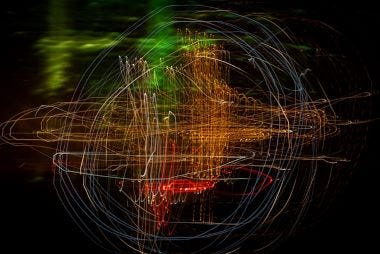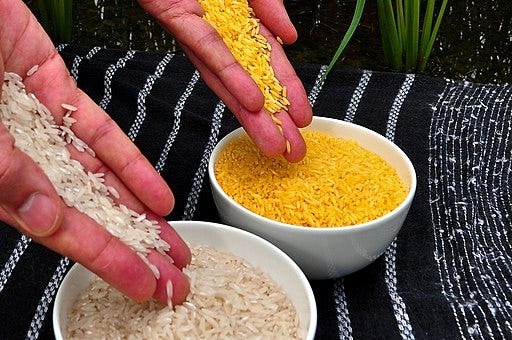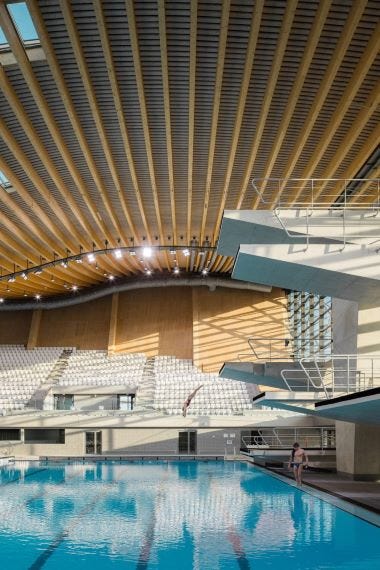1 Week, 7 Stories #28
Another pandemic fail, wood construction making the grade, Golden Rice faces more challenges, and the tiny, but sensitive hummingbird.
Every edition features 7 stories, from the past week. I’ll draw on my background in media, journalism, agriculture, biotech, and renewable energy to come up with an interesting selection and do my best to offer some context.
Sometimes built around a theme, sometimes random, but with a Canadian twist.
So are you sitting comfortably? If so let’s begin.
To define biodiversity, all you have do is look around you. The American Museum of Natural History says the term refers to life at all its levels, “from genes to ecosystems, and can encompass the evolutionary, ecological, and cultural processes that sustain life”. As we lose natural biodiversity, ecosystems stop functioning effectively, our environment is less resilient, food and fresh water are less abundant, and every living thing (including you and me) are more prone to disease and pests.
In The Conversation this week 4 people who study biodiversity zeroed in on British Columbia and pointed out that the province’s fragmented approach to monitoring biodiversity means that potential threats could be missed.
BC is not alone.
In the Yukon, the Kluane First Nation is pushing for measures to protect the territory’s dall sheep population. It is the second year they have called for action, but the territorial government cannot seem to come to a decision.
The frustrating part of biodiversity conservation is that we know what needs to be done and we have seen it work. The article about BC points out that we have sophisticated tools at our disposal, there are organizations dedicated to making it work, and we have the knowledge. A BBC story says that two out of three conservation measures that were part of a recent study had a positive effect.
One of the outcomes of the UN’s COP15 biodiversity conference was an agreement to protect 30% of the planet’s land and water by 2030. Here is a snapshot of how we are faring.
As for what we can do as individuals, I’ll send you back to British Columbia for some ideas.
We have had a good mix of weather here in Alberta lately and the trees in my yard are looking green, healthy, and in some cases loaded with blossoms ready to become crabapples. Trees are important to supply food, shelter, control soil erosion, and provide habitat for many species. They are also touted as a nature-based way of dealing with climate change. Roughly 50 trees will suck up one tonne of CO2 and convert it into oxygen (and ultimately more trees).
Canada wants to plant 2 billion trees by 2031.
New Zealand had similar ambitions, but a Bloomberg story this week says that is not panning out. (should be a free link but if you have problems accessing it try Phys.org)
The new trees started to push out meat and dairy operations and the leftover slash from logging created new problems.
The debate about the value of mass tree planting seems to come down to how it is implemented. Often fast-growing trees are chosen which take over natural ecosystems and encourage logging which comes with its own damaging side effects. The priority instead should be on protecting existing forests, encouraging natural reforestation, and exercising careful planning to ensure tree planting programs don’t end up doing more harm than good.
As for Canada’s $3.2 billion dollar program? An audit says it is not going as planned either.
News.
Your definition may well be different than mine, but in general it is reporting about current events. Anything from politics, to science, to sports, to arts, to culture and everything in between.
I subscribe to several sources which include mainstream outlets, online news, and podcasts. That puts me outside the norm because between 80 and 90 percent of Canadians do not have paid online subscriptions. Instead, they are relying on search results, social media, and free news sites. That is becoming risky business now that Google is offering instant answers generated by artificial intelligence. No more will you have to go to all the bother of clicking a link, reading the information, and formulating an opinion. Instead, you can rely on some of the latest, but little-known information journalists and users have been able to uncover this week. It assures us that Buzz Aldrin deployed cats on the Apollo 11 mission and that cats have landed on the moon. It also let us know that Barrack Obama was the first Muslim president of the United States (he was not) and that to make cheese stick to pizza use non-toxic glue (please don’t!). Google says this takes the legwork out of searching. I know, I know, it is exhausting having to read and evaluate information.
Right now this new search tool is only available in the United States, but it will eventually find its way into every digital nook and cranny.
At least one theory about why weird results come up, is that AI’s scraping of the Internet includes overtly misleading sites and satirical sites such as The Onion.
Which takes us to the use of legitimate news used to help AI in its quest to answer our questions. As a story in The Conversation notes, AI is a “ravenous beast” and goes on to say there is a reckoning coming on whether news outlets work with AI or fights it.
Rupert Murdoch’s News Corp has signed a deal with OpenAI which leans towards working with it. The deal will allow OpenAI to “learn” from News Corp publications including The Wall Street Journal, New York Post, The Sun, and The Daily Telegraph. The New York Times and eight other US newspapers on the other hand, have chosen to fight it and are suing over the use of their content.
AI should not be allowed to supplant original journalism and AI is not going to go away, so is there a middle ground? A Washington Post story on Monday sheds light on where that middle ground lies. A magazine chain which includes People, Food & Wine and InStyle reached a deal with Microsoft and OpenAI which will allow ChatGPT to tap into the magazine archives in return for links back to the original articles.
I remember when I was taking computer programming in university and ran into endless loops in my flawed coding. The result was a sequence that ran over and over with no way out. We could be headed into a future where AI scrapes for stories, generates new stories, and scrapes for more stories including those generated by AI.
Layer upon layer of AI stories.
Caught in an endless loop with no way out.

We at least can agree that pandemics are not a good thing, but when it comes to preventing them a global treaty to fight future pandemics remains elusive. Even after 2 years and nine rounds of negotiations nothing was agreed on. The chief US negotiator to the talks said there were “fundamental differences” on core issues. It was clear a couple of weeks ago that there was little chance of agreement, but when the World Health Assembly convened on Monday it was confirmed.
Right wing politics in the United States is not a big fan of globally binding treaties and Senate Republicans demanded the US withdraw because it was an infringement on US sovereignty and free speech. Lower income countries were concerned about the equitable distribution of technology, vaccines, and intellectual property in dealing with future outbreaks. Reuters reported that Britain opted out because its negotiators said the country would have to give away a fifth of its vaccines.
These are some of the very issues which lead to regional disease outbreaks becoming wider problems and potentially pandemics. During COVID, Al Jazeera rightly points out that “glaring gaps” in vaccine access between rich and poor countries were all too obvious. Data exchange was closely guarded at a time when it could have made a difference and tended to foster mistrust between countries.
Seems we have short memories when it comes to how we ended up with a global problem and according to the Coalition for Epidemic Preparedness Innovations there is still work to be done.
If the failure of the recent negotiations is any indication, we may be destined to make the same mistakes again.

Golden Rice is a genetically modified rice variety high in beta-carotene which can double the intake of vitamin A.
According to UNICEF, vitamin A deficiency is the leading cause of preventable childhood blindness and increases the risk of death from common childhood illnesses. (the link also includes a useful interactive map)
Given the high rate of children suffering from vitamin deficiency, the fact that rice is the primary source of energy for more than half of the global population, and that it has met food regulatory standards in many countries – including Canada - why is there not more of it?
Because it is genetically modified rice and perhaps secondarily because the Bill & Melinda Gates Foundation invested in the research and development.
The GMO label and the Gates name make it a target for activists and global conspiracy theories.
With Greenpeace leading the charge, a Philippines court decision has blocked the growing of Golden Rice in that country. The Philippines was the first country to approve the rice in 2021, but the Greenpeace funded appeal overturned the approval. The Guardian this week reported that the decision could have “catastrophic consequences”.
The modification of the rice was the science of genetic manipulation at its simplest level. No genetic material from a different species was introduced into the rice. Rice plants already contain beta carotene but only in the leaves and stems. The genetic engineering forced the plant to express the genes in the kernels. The golden colour (and the name) comes from the newly expressed genes.
When I first started working in the biotech field, Golden Rice was a technical success, but was not ready for commercialization. That changed by the time I moved on. It was tweaked by researchers, is a sustainable crop, and has passed all government and peer-reviewed safety studies. Equally important is that the rice was developed for humanitarian reasons and its distribution and licensing is overseen by the Golden Rice Humanitarian Board to ensure countries that need it are not hindered by prohibitive licensing costs.
An opinion piece in The Spectator says that the appeal decision is “a devastating blow to the scientific community in the Philippines, and the humanitarian groups who were hoping Golden Rice could be used to help save the lives of young children across Asia and Africa”.
Genetically modified crops can be developed that are more resistant to pests and diseases, have higher yields per acre, or in the case of a new Agriculture Canada wheat test plot, be more resistant to drought conditions.
These crops are part of our future.
Watching a hummingbird hover over a flower (or your feeder) to get at the nectar then suddenly dart off without ever bumping into the flower is a fascinating sight.
A paper published in Current Biology this week, outlines a study that determined just how these tiny manage to flit from flower to flower with such precision. The work was led by Duncan Leitch who is affiliated with both the University of British Columbia and the University of California Los Angeles. Depending on where you find more information it is either a UCLA- or UBC- led study but as one of the other authors is also from UBC, I’ll go with that!
The researchers found that hummingbirds are extremely sensitive to touch and even to slight puffs of air. In a UBC story, Leitch said, “We found disproportionately large areas of the brain responding to touch were devoted to the wings and the feet, and even specific areas of the wing that were poised to detect different kinds of gusts and drafts,”
Apart from the insight gained into the movement of the hummingbird, the results will also help bird researchers with a better understanding of how birds react to pain when injured or being handled.
Hummingbirds are only found in the Western Hemisphere and many of them spend the winter in Central America and Mexico before the long-haul flight to Canada. At least that is the plan. In October of 2022 a Costa’s hummingbird got lost and ended up in Saskatoon - miles from where it should be - and had to overwinter in a wildlife rehabilitation centre. He was set free in August of 2023 in the hopes he would find his way back to where he belonged – in the deserts of Mexico and the US.
By the way, it isn’t too late to attract hummingbirds to your own backyard. Birds Canada has some tips.
Years ago, I lived in a house with a wood basement. It was drier, easier to renovate, and warmer. It was also a rare way to build a basement foundation in Alberta. I have also lived in log homes. One with large natural logs and one with pre-cut manufactured logs. Both had high thermal mass and R values.
So I was interested to see wood for construction getting some new attention.
In Alberta, Western Archrib has just completed a new manufacturing facility to meet the growing demand for mass timber which is a building material made by binding layers of wood together to create larger and stronger panels and beams. (my wood basement home also had mass timber beams and they looked great)
According to a CBC story, mass timber made up only 1% of all building construction materials in North America in 2022 but the market is expanding. Advocates of mass timber say it is faster and easier to work with and less carbon intensive. Bloomberg News found climate-friendly claims were not quite so straight forward. One of the key concerns is that while an individual building might score some green points, what happens if a million structures require wood for construction.
Modern mass timber products are strong enough to build more than just residential homes and Ontario is expanding its Building Code to allow encapsulated (fire-rated treatments) mass timber construction up to 18 storeys. Builders of a wooden high rise outside Tokyo found that comes at a higher initial cost however, but with the added benefit of being resistant to earthquake shocks.
Currently the tallest mass timber-concrete hybrid building is a 25-storey residential and retail complex in Milwaukee, and the tallest all-timber record holder is 18 storeys in Norway according to the Council on Tall Buildings and Urban Habitat.
Wood will also get a few weeks in the media spotlight during the upcoming Paris Olympics. One of the only permanent structures built for the event is the Aquatics Centre which has been constructed predominantly with wood.
Read, comment, subscribe, and share this newsletter.
I’m available for contract and freelance work with not-for-profits and charities. With 40 years of experience behind me and lots of time ahead of me, I’m here to help you make a difference in your media relations, public relations, and general communications needs.


